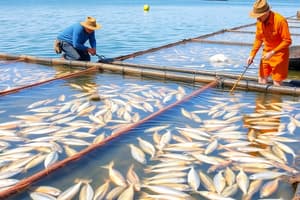Podcast
Questions and Answers
What is the primary purpose of aquaculture?
What is the primary purpose of aquaculture?
- To conserve marine biodiversity
- To reduce the pressure on overfished stocks
- To provide a sustainable alternative to wild-caught fisheries (correct)
- To cultivate aquatic plants and animals for scientific research
What type of aquaculture involves culturing fish and other aquatic organisms in freshwater environments?
What type of aquaculture involves culturing fish and other aquatic organisms in freshwater environments?
- Integrated Multi-Trophic Aquaculture
- Brackish water aquaculture
- Freshwater aquaculture (correct)
- Marine aquaculture
Which of the following is an example of a finfish species?
Which of the following is an example of a finfish species?
- Lobster
- Salmon (correct)
- Kelp
- Shrimp
What is a major challenge facing the aquaculture industry?
What is a major challenge facing the aquaculture industry?
What is the purpose of Best Management Practices (BMPs) in aquaculture?
What is the purpose of Best Management Practices (BMPs) in aquaculture?
What is Integrated Multi-Trophic Aquaculture (IMTA)?
What is Integrated Multi-Trophic Aquaculture (IMTA)?
What is the primary benefit of Recirculating Aquaculture Systems (RAS)?
What is the primary benefit of Recirculating Aquaculture Systems (RAS)?
What is a major benefit of aquaculture?
What is a major benefit of aquaculture?
Flashcards are hidden until you start studying
Study Notes
Definition and Importance
- Aquaculture is the practice of culturing aquatic plants and animals in controlled environments, such as ponds, tanks, and nets.
- It is a significant source of food and income for millions of people worldwide.
- Aquaculture provides a sustainable alternative to wild-caught fisheries, helping to conserve marine biodiversity and reduce the pressure on overfished stocks.
Types of Aquaculture
- Freshwater aquaculture: Culturing fish and other aquatic organisms in freshwater environments, such as ponds and tanks.
- Marine aquaculture: Culturing fish and other aquatic organisms in saltwater environments, such as ocean cages and nets.
- Brackish water aquaculture: Culturing fish and other aquatic organisms in a mixture of fresh and saltwater environments.
Aquaculture Species
- Finfish: Fish species such as salmon, tilapia, and catfish.
- Shellfish: Mollusk species such as oysters, mussels, and shrimp.
- Crustaceans: Crustacean species such as lobsters and crabs.
- Algae: Aquatic plant species such as seaweed and kelp.
Benefits and Challenges
- Benefits:
- Increased food production and nutrition
- Job creation and economic growth
- Conservation of marine biodiversity
- Improved food security
- Challenges:
- Environmental impact (e.g., water pollution, habitat destruction)
- Disease and parasite management
- Feed and nutrition management
- Social and economic impacts on local communities
Sustainable Aquaculture Practices
- Best Management Practices (BMPs): Guidelines for responsible aquaculture practices, such as water quality monitoring and waste management.
- Integrated Multi-Trophic Aquaculture (IMTA): A system that combines different species and trophic levels to mimic natural ecosystems and reduce waste.
- Recirculating Aquaculture Systems (RAS): Closed-loop systems that recycle water and reduce waste.
- Organic and eco-certified aquaculture: Practices that adhere to standards for environmental sustainability and social responsibility.
Definition and Importance
- Aquaculture is the practice of culturing aquatic plants and animals in controlled environments, such as ponds, tanks, and nets.
- It is a significant source of food and income for millions of people worldwide.
- Aquaculture provides a sustainable alternative to wild-caught fisheries, helping to conserve marine biodiversity and reduce the pressure on overfished stocks.
Types of Aquaculture
- Freshwater aquaculture involves culturing fish and other aquatic organisms in freshwater environments, such as ponds and tanks.
- Marine aquaculture involves culturing fish and other aquatic organisms in saltwater environments, such as ocean cages and nets.
- Brackish water aquaculture involves culturing fish and other aquatic organisms in a mixture of fresh and saltwater environments.
Aquaculture Species
- Finfish include fish species such as salmon, tilapia, and catfish.
- Shellfish include mollusk species such as oysters, mussels, and shrimp.
- Crustaceans include crustacean species such as lobsters and crabs.
- Algae include aquatic plant species such as seaweed and kelp.
Benefits and Challenges
- Benefits of aquaculture include increased food production and nutrition, job creation and economic growth, conservation of marine biodiversity, and improved food security.
- Challenges of aquaculture include environmental impact (e.g., water pollution, habitat destruction), disease and parasite management, feed and nutrition management, and social and economic impacts on local communities.
Sustainable Aquaculture Practices
- Best Management Practices (BMPs) are guidelines for responsible aquaculture practices, such as water quality monitoring and waste management.
- Integrated Multi-Trophic Aquaculture (IMTA) is a system that combines different species and trophic levels to mimic natural ecosystems and reduce waste.
- Recirculating Aquaculture Systems (RAS) are closed-loop systems that recycle water and reduce waste.
- Organic and eco-certified aquaculture practices adhere to standards for environmental sustainability and social responsibility.
Studying That Suits You
Use AI to generate personalized quizzes and flashcards to suit your learning preferences.




